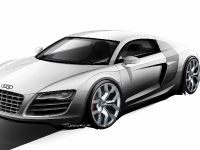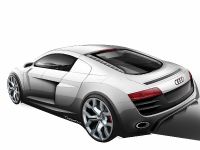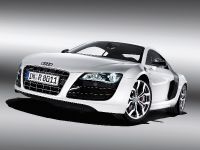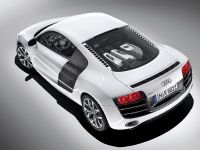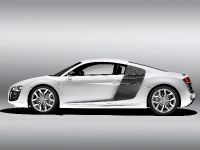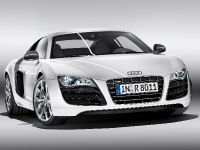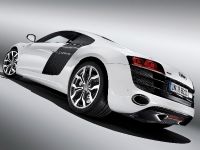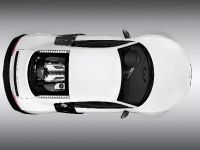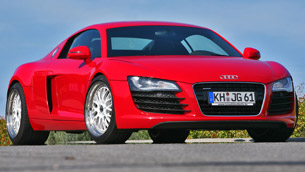Audi R8 5.2 FSI quattro
Audi continues to vigorously advance its successful strategy in the high-performance sports car segment. With the R8 the brand has established itself there right from the start – now follows the R8 5.2 FSI quattro. Its ten-cylinder engine churns out 386 kW (525 hp) and 530 Nm (390.91 lb-ft) of torque, which makes for breathtaking performance. With its distinctive design and superior Audi technologies such as quattro all-wheel drive, the lightweight aluminum body and the innovative, all-LED headlights, the R8 V10 takes pole position in its competitive field.
A new dimension in dynamics
Audi continues to reinforce its leading position in the high-performance sports car segment – in the R8 5.2 FSI quattro it is rolling out the new top-of-the-line model of the R8 model series, which was developed jointly with quattro GmbH. Its ten-cylinder engine develops 386 kW (525 hp), which is capable of delivering breathtaking performance. Audi technologies such as quattro permanent all-wheel drive, the lightweight aluminum body and the innovative all-LED lights propel the new top Audi model right to the top of its competitive field.
A zero to 100 km/h (62.14 mph) sprint of 3.9 seconds and a top speed of 316 km/h (196.35 mph) exemplify the breathtaking dynamics of the R8 5.2 FSI quattro. And this car serves these up as exhilarating power experiences – with a ferocious response to the gas pedal, outstanding revving ability, and a thrilling crescendo of technological music.
The V10 engine is firmly rooted in Audi's great motorsport tradition. It revs all the way up to 8,700 rpm – almost as high as a racing engine. At 6,500 rpm the naturally aspirated 5.2-liter engine delivers a full 530 Nm (390.91 lb-ft) of torque, at 8,000 rpm it achieves its maximum power output of 386 kW (525 hp).
The specific power output is 100.9 hp per liter of displacement, while its power-to-weight ratio is just 3.1 kilogram (6.83 lb) per hp.
The 5.2-liter engine uses direct injection according to the FSI principle developed by Audi. It achieves a compression ratio of 12.5:1, which contributes substantially to the high power output and the moderate fuel consumption. The R8 5.2 FSI quattro – in the version with the sequential R tronic transmission – gets by on an average of 13.7 liters per 100 km (17.17 US mpg). Dry sump lubrication is another technology derived from motorsport that ensures oil feed in any position – even at the maximum transverse acceleration of 1.2 g that this high-performance car from Audi reaches.
Audi delivers the R8 5.2 FSI quattro with manual six-speed transmission, or optionally with R tronic, which enables the driver to change gears in an instant via rocker switches on the steering wheel. The "Launch Control" function is integrated with both types of transmission – a program that catapults the car forward from a standing start. The quattro permanent all-wheel drive distributes the engine's torque to all four wheels, with a strong bias towards the rear wheels.
The R8 5.2 FSI quattro features an axle load distribution of 44 to 56 percent – ideal for a mid-engine sports car. All four wheels are guided by dual aluminum wishbones. The suspension is tuned for a highly dynamic ride, yet preserves an appreciable degree of comfort thanks to Audi magnetic ride. This standard technology continually adapts the function of the shock absorbers to the requirements of the driver and the road.
Exclusive 19-inch wheels of 10-spoke Y design are standard equipment. The front wheels are equipped with size 235/35 tires, the rear with size 295/30 tires. The brakes likewise deliver out-and-out performance. Optionally available from Audi are carbon-fiber ceramic brake disks, which are extremely lightweight and durable.
Setting the standard in lightweight design: The ASF body The R8 5.2 FSI quattro with six-speed manual gearshift tips the scales at a modest 1,620 kilograms – mainly thanks to its lightweight body. Built of aluminum in the Audi Space Frame design, it weighs a mere 210 kilograms (463 lb). The ASF design is extremely rigid, which ensures dynamic, precise and secure handling as well as occupant safety.
The interior of this high-performance sports car from Audi provides astonishing roominess. Behind the seats and under the front hood is room for 190 liters (6.71 cubic ft) of luggage. The car is luxuriously equipped – heated seat covers of Fine Nappa leather, the navigation system plus, the Bang & Olufsen sound system and automatic air conditioning are standard equipment. Carefully arranged interior details underscore the leading position of this top-of-the-line model.
The exterior of the R8 5.2 FSI quattro also differs distinctly from that of its V8 counterpart – with especially notable changes at the front, at the sideblades which provide the engine with intake air, and at the tail end. A very distinctive highlight of the R8 V10 are the all-LED headlights as standard equipment. Audi is the world's first automaker to use LEDs for the high beam, low beam, daytime running lights and turn signals.
Just like the eight-cylinder model, the ten-cylinder version is hand-built at quattro GmbH in Neckarsulm. The Audi R8 5.2 FSI quattro will be rolled out in Germany in the second quarter of 2009. Its base price is EUR 142,400.
At a glance
Engine * Newly developed V10 with 5.2 liters displacement, FSI direct injection and dry| sump lubrication. * Superior performance 386 kW (525 hp) and 530 Nm (390.91 lb-ft) of torque * Superlative performance: 0 – 100 km/h (62.14 mph) in 3.9 seconds, top speed 316 km/h (196.35 mph)
Power train * Six-speed manual transmission; optionally sequential R tronic with rocker switches on steering wheel and "Launch Control" function * quattro permanent all-wheel drive with rear-wheel bias
Chassis * Dual aluminum wishbone suspensions all around * High-performance brakes, optionally with ceramic disks * 19-inch wheels for high transverse acceleration and powerful grip * Audi magnetic ride adaptive suspension is standard equipment
Body and design * Lightweight yet extremely rigid aluminum body in ASF design, weighs only 210 kilograms (463 lb) * Surprisingly spacious interior and high level of everyday utility * Exterior and interior design with distinctive new elements * All-LED lights as standard
Equipment * Extensive standard equipment including navigation system plus, Bang & Olufsen sound system and automatic air conditioning
Engine
The R8 5.2 FSI quattro is a winner – its genes contain the cumulative experience of eight Le Mans triumphs and many other victories achieved by Audi over the past nine years. And the new top-of-the-line version retains these close links to motorsport: Starting in spring, its ten-cylinder engine in virtually unchanged form will display its potential on the racetrack – in the new R8 LMS racing car, which Audi is readying for the customer sports segment in accordance with the GT3 rules.
The V10, which is to a large extent a new development, exploits a total displacement of 5,204 cc and is designed to rev up easily. At 6,500 rpm it delivers 530 Nm (390.91 lb-ft) of torque and at 8,000 rpm it puts out 386 kW (525 hp). Its limit isn't reached until 8,700 rpm – when each piston travels 26.9 meters (88 ft) per second. The specific power output is 100.9 hp per liter of displacement. And every hp only needs to propel 3.09 kilograms (6.81 lb) of weight, because the high-performance sports car in the version with the manual transmission only weighs 1,620 kilograms (3,571 lb).
0 – 200 km/h: 12.0 seconds The Audi R8 5.2 FSI quattro provides superior performance. It rockets from zero to 100 km/h (62.14 mph) in 3.9 seconds. In the version with the sequentially shifting R tronic it passes the 200 km/h (124.27 mph) mark in another 8.1 seconds. And its powerful propulsion continues well beyond that, to a top speed of 316 km/h (196.35 mph).
The immense power, the eager response to the gas pedal, the outstanding revving ability, the palpable force of acceleration, and the thrilling sound – all these impressions combine to give a truly thrilling sports car experience. The V10 is a highly sonorous engine with growling bass tones and powerful high notes, which grows into a spectacular fortissimo as the engine revs up. Two sound baffles in the exhaust system that are controlled by underpressure modulate its volume and pitch as a function of the load and the engine speed.
The ten-cylinder layout is the ideal solution for maximum dynamism. Compared to a V8 with the same displacement, a V10 has smaller and lighter pistons and connecting rods, which makes it a free-revving engine. Compared to a V12, on the other hand, it has fewer components, resulting in lower moving masses and less internal friction. And it is very compact – even with all attached components the 10-cylinder engine is only 646 millimeters (25 in) long, 737 millimeters (29 in) wide and 696 millimeters (27 in) high.
V-angle of 90 degrees for a low center of gravity The V10 is a member of the Audi family of V-engines with a 90 degree cylinder angle. This large cylinder angle results in a low center of gravity. The banks face each other with an offset of 18.5 millimeters (0.73 in), the bore is 84.5 millimeters (3.3 in), the stroke 92.8 millimeters (3.6 in). To achieve maximum rigidity with minimum weight, the crankshaft was designed as a common-pin shaft, which results in alternating ignition distances of 54° and 90°. This ignition sequence is one of the reasons for the racing-like sound of the V10 engine.
The crank case is produced by a low-pressure diecasting method of a hypereutectic aluminum-silicon alloy – a high-tech material that combines low weight with high strength. The high silicon content of this alloy endows the cylinder tracks with the required wear resistance to withstand the very high average piston velocity of up to 26.9 m/s. The entire engine weighs only 258 kilograms (569 lb), just 31 kilograms (68 lb) more than the V8.
The bedplate design – the lower bearing brackets for the crankshaft are integrated into a single frame – provides the crankcase with maximum rigidity and optimum vibration behavior. Integrally cast iron bearing brackets reduce the thermal expansion of the aluminum housing and minimize the play in the main crankshaft bearings. The forged crankshaft and the forged-steel con rods combine high strength with low weight. The pistons are forged of a high-strength aluminum alloy.
The V10 obtains its oil, which is temperature-controlled by dual coolers, from a dry sump – a design that allows the engine to be installed very low. The external container and the oil pump module, which is designed to work very efficiently with several suction levels and pressure levels, ensure lubrication under any conditions – even during the extreme transverse acceleration exceeding 1.2 g of which the R8 5.2 FSI quattro is capable.
The camshafts, as well as the oil pump, the water pump and parts of the accessory subsystems, are powered by maintenance-free chains located on the rear wall of the engine. All four camshafts are adjustable through 42 degrees crank angle, which provides a wide range of control times for the 40 valves, which are actuated by roller-mounted cam followers. The exhaust valves are subject to a high thermal load and are lined with sodium to assist in cooling.
High Cylinder Filling and Perfect Mixture Formation The induction pipe is made of lightweight plastic and designed for optimized flow conditions through the ports. Integrated in the intake ports are tumble flaps that are controlled by the engine management system. During low-load conditions, these tumble flaps stroke the inducted air inward to impart motion to it, which improves the efficiency of the combustion process. At full load, the tumble flaps adapt their shape to the contour of the intake ports to optimize the flow.
On the exhaust side, the dynamics of the gas exchange are supported by individual elbow joints. They are precisely attuned to the operation of the ten-cylinder engine.
The ten-cylinder engine uses direct injection as per the FSI principle developed by Audi. In the Audi R8 racing car it has impressively demonstrated its superiority in five overall victories in the Le Mans 24 Hours. A common rail system injects the fuel with up to 120 bar of pressure into the combustion chambers through valves placed laterally on the cylinder. This injection strategy causes internal cooling and consequently allows a very high compression ratio of 12.5:1. It contributes both to the high power output and to high efficiency. The engine gets by on an average 13.7 liters of fuel per 100 kilometers (17.17 US mpg).
The V10 is managed by a highly advanced control system that employs two computers in a master-slave arrangement.
Power train
The double-disk clutch in the R8 5.2 FSI quattro is very compact, an advantage which is actually a necessity due to the low position of the engine. The standard transmission is 6-speed manual. The driver moves the shift lever in short steps through an elegant stainless steel profile, with precision and the greatest of ease – a characteristic Audi feature.
As a customer option, Audi will equip the R8 5.2 FSI quattro with the sequential R tronic. With the short selector lever and its rocker switches in an elegant aluminum finish on the steering wheel, it communicates an authentic racing feel. The shifting speed varies with the requirements: in a moderate driving style, the gear change occurs at a comfortable rate; at high load and revs it shifts extremely quickly, within a mere tenth of a second.
Chassis
For the Audi R8 5.2 FSI quattro high-performance sports car the mid-engine concept is the ideal solution. It results in an axle load distribution of 44 : 56, and it locates the engine close to the vertical axis, in the center of the car – so that the inertia of the engine's mass hardly matters during swift direction changes.
A tour over a mountain pass or an excursion on a racetrack in the R8 5.2 FSI quattro is a truly amazing experience – the very epitome of dynamism. The high-performance sports car from Audi reacts to all steering commands with lightning speed, almost instantly. It attains extreme speed in the turns while staying practically neutral, and retains poise and safety in any situation. A contributing factor is the special kinematics of the rear axle – the predefined toe-in angle of the wheels under load ensures grip and stability.
Notwithstanding the exciting dynamics, the suspension provides surprisingly good comfort on long drives. The dual wishbones that steer all four wheels – a racing car feature – are forged of aluminum to reduce the unsprung mass. Rubber-metal bearings transfer the transverse forces precisely into the body. They also provide good longitudinal elasticity and absorb much of the undesirable vibrations from the roadway.
Developed on the North Loop: The fine-tuning The hydraulic rack-and-pinion power steering contributes much of the feel of uncompromising precision which the R8 5.2 FSI quattro conveys. It delivers a highly differentiated, sensitive feedback via a sporty 17.3 : 1 ratio. The setup of the suspension is designed for even higher performance than in the eight-cylinder R8 – Audi has fine-tuned it with 8,000 test drive kilometers in the world's toughest laboratory, the North Loop of the Nürburgring.
A standard high-end feature further broadens the dynamic spectrum – Audi magnetic ride adapts the operating mode of the suspension to the road's profile and the driver's style. The driver can switch over anytime between the comfort-oriented normal mode and the crisply firm sport mode. The pistons of the shock absorbers contain a circulating synthetic hydrocarbon oil in which small magnetic particles are suspended that measure only between three and ten thousands of a millimeter – about one-tenth the diameter of a human hair.
Applying a voltage to a coil causes a magnetic field in which the orientation of the particles change: they then impede the flow of the oil through the piston channels by orienting themselves crosswise to the flow direction. This happens in just a few milliseconds, much faster than the response in conventional adaptive dampers.
Using data from a complex sensor system, a control device continually recalculates the optimum values for each individual wheel. When the R8 5.2 FSI quattro heads into a curve, the damping force at the wheel on the outside of the curve is increased, which reduces the tilt of the body and increases the spontaneity of the response.
The new top model of the R8 series relies on a big tread – 19-inch wheels complete with tire pressure monitor. They are equipped with 10 spokes in a Y arrangement designed especially for the V10 and are brilliantly polished. Tire sizes – also for the winter tires – are 235/35 front and 295/30 rear. Optionally available in the same size from quattro GmbH are wheels with a five twin-spoke design with a titanium-gray or brilliantly polished finish.
Racing performance: The braking system Deceleration is provided by a powerful braking system with lightweight aluminum calipers. The front brakes are equipped with fixed calipers with 8 pistons each, the rear brakes with 4 pistons each. The brake disks are internally ventilated and perforated to maximize heat dissipation.
The front brake disks are 365 millimeters (14.4 in) in diameter, the rear disks 356 millimeters (14 in). Each disk consists of a steel friction ring and an aluminum hub. They are interconnected by stainless steel pins, which prevents the transfer of temperature spikes.
As a customer option, Audi will equip the R8 5.2 FSI quattro with ceramic brake disks. They are painted anthracite gray and adorned with the exclusive "Audi ceramic" logo. In front, the braking effect is generated with a six-piston monoblock aluminum caliper and a brake disk with a diameter of 380 millimeters (15 in). In the rear, floating calipers and ceramic disks with a 356-millimeter (14 in) diameter are installed. Their base material is silicon carbide, an extremely hard, abrasion-resistant material with a diamond-like crystalline structure. Embedded in it are high-strength carbon fibers that absorb mechanical stresses.
The complex geometry of the cooling ducts ensures swift heat dissipation. Ten threaded elastic pins connect the friction ring to a stainless steel hub which in turn connects to the wheel hub. These ceramic disks are especially light: their combined weight is nine kilograms less than the weight of equivalent steel disks. They also hold up very well under the stresses of more aggressive driving and always remain free of corrosion.
The boundary region of the driving dynamics of this high-performance sports car is monitored by a specially designed stabilization system. By pressing a button it can be switched into a sport mode, which allows accelerating out of a curve with spectacular but safe oversteering. For especially dynamic driving, such as on a fast lap around a racetrack, the ESP including the automatic traction control can also be completely deactivated.
To provide passive safety, the car is equipped with two front airbags with two-stage triggering as well as head and chest sidebags. The integral head restraint system reduces the risk of a whiplash injury in a rear end collision.
If desired, R tronic can also shift gears fully automatically. The driver can control its operation through four different programs – two each in the manual and in the automatic mode. The most comfortable R tronic mode is "Automatic Normal", the most dynamic is "Manual Sport".
R tronic is equipped with a separate hydraulic oil circuit. The integrated power unit provides the required pressure of 40 to 50 bar. The hydraulics actuates the clutch and changes the gears. The driver's commands are transmitted "by wire", i.e. electrically.
A standard feature of R tronic is the "Launch Control" program, which enables the R8 5.2 FSI quattro to make lightning-fast starts fully automatically. The driver activates it with a delightful little procedure: Select Shift Program S, deactivate traction control, select gear, step on brake pedal, press gas pedal to the floor, and wait until a constant engine speed is shown on the tachometer. If you now release the brake, Launch Control does the rest. It actuates clutch engagement within milliseconds, the V10 engine matches its immense power to the ideal degree of tire slip for the best possible acceleration on the road.
A contributing factor to the wide lead in traction and driving safety with which the Audi R8 V10 leaves the competition trailing is the quattro all-wheel drive – this is the superior technology for a high-performance sports car in particular. Four powered wheels get more grip than two. They enable the driver to step on the gas sooner when coming out of a curve. Other benefits include transverse dynamics and stability: The high-performance sports car provides an entirely safe and trouble-free ride.
The R8 model series with its mid-engine concept is a special formulation of the quattro lineage. From the transmission, which is located lengthwise behind the V10, a drive shaft extends forward through the engine to the front axle differential. This is where a viscous coupling distributes the power between the front and rear wheels. In regular driving, it distributes about 85 percent of the torque to the rear axle. But if necessary it can transfer up to 30 percent to the front within a few milliseconds. At the rear axle, a mechanical limited-slip differential further increases the traction. Its locking power amounts to 25 percent in traction and 40 percent in thrust.
Body
In terms of its body characteristics, too, the Audi R8 5.2 FSI quattro is at the top of its class. Built of aluminum in the Audi Space Frame (ASF) design, it weighs a mere 210 kilograms (463 lb). In the quality of its lightweight construction – the relation of weight, size and torsional rigidity – the ASF earns the best score in the sports car segment, which lays the foundation for its precise handling and its high level of crash safety.
Since the development of the first A8 in the early 1990s Audi has held pole position in aluminum lightweight design. In the ASF technology, the weight-bearing structure is composed of three groups of components, each of which combines maximum stability with minimum weight. Aluminum extrusions make up 70 percent of the body-in-white, vacuum-cast nodes 8 percent, and sheet aluminum panels, which also bear weight, make up 22 percent.
Firm connections: High-tech production The ASF of the Audi R8, which integrates a weight-bearing engine frame of ultralight magnesium, is produced largely by hand in the Neckarsulm manufacturing plant of quattro GmbH. Maximum precision and the use of the most advanced joining techniques are taken for granted here: 99 meters of welding seams, 782 rivets and 308 self-tapping screws hold the body together. A fully automatic measuring system checks the dimensions of every single body with a precision in the one-tenth millimeter range.
An important component of the ASF is the separation wall between the passenger compartment and the engine compartment. It is lined with special materials on both sides, and the window is made of a sound-dampening glass – so the music of the ten cylinders behind the driver conveys a sense of energy but is never intrusive.
Exterior
The stance of the Audi R8 5.2 FSI quattro is broad and low, as if ready to leap. The powerful proportions and the large wheel wells underscore its potential. Typical for the brand of the four rings is the exquisite precision in handling lines, the sculpted look even of flat areas, and the elegant flow of the curved roof. Another typical Audi feature is the close relation to motorsport: The basic design of the R8 came from the same team that designed the triumphant Le Mans racing car.
A continuous contour (the "loop") optically connects the front, the wheel wells, the sides and the rear. Located well forward, the cab visually expresses the mid-engine design. The vertical air vents at the sides, called sideblades, are also indicative of the engine position and are flared further outwards. The massive aluminum gas cap is mounted flush within the right sideblade.
Distinctive details: The look of the R8 5.2 FSI quattro The distinctive design of the Audi R8 has met with great approval among automotive professionals. The dual victory in the selection of the "World Car of the Year Awards 2008" – as "World Performance Car" and as "World Car Design" is an expression of this. In the ten-cylinder model, the styling has been sharpened up a bit more.
Audi has adopted Sepang Blue, pearl effect as a paint finish exclusive to the 5.2 FSI quattro. The customer can also choose one of eight other colors, as well as one of eight standard colors for the sideblades. The air intakes in front, providing airflow to the water coolers and the brakes, as well as the lip of the front apron, are painted in a high-gloss black. The intakes have only two instead of three cross braces – which makes them look even bigger and hungrier. The braces of the large single-frame grille, which is also painted in high-gloss black, are embellished by distinctive chrome designs. As in the eight-cylinder R8, the four rings are not mounted within the grille but on top of the front hood.
A very distinctive highlight of the R8 5.2 FSI quattro are the all-LED headlights as standard equipment. Audi is the world's first automaker to use LEDs for the high beam, low beam, daytime running lights and turn signals. In this highly complex technology, lens and reflector systems, intelligent ballasts and fan-driven coolers interact. Although the chips emit so-called cool light, they actually heat up, and their temperature must be kept within a defined range.
With a color temperature of 6,000 Kelvin, the LED light closely resembles white daylight, which is less tiring to the eyes when driving at night. The excellent light distribution and virtually unlimited service life of LEDs are additional benefits. What's more, their energy consumption is already substantially lower than in halogen lights – an efficiency gain that will increase as a result of development in the coming years.
The look of these lights is also attractive and distinctive. The daytime running lights form a dynamic curve just below the headlights. They consist of 24 LEDs, which appear not as a chain of separate light sources but as a continuous ribbon. And the reflectors, located toward the single-frame grille, are reminiscent of open seashells.
Like a work of art in a showcase: The engine There are many other special details on the body of the R8 5.2 FSI quattro. V10 badges on the forward sidewalls announce the big engine. The sideblades – the air intakes for the engine, oil cooler and rear brakes – are flared outward further than in the eight-cylinder version and have an additional edge.
The side sills are significantly wider as well; the exhaust grilles at the rear windows retain their matt aluminum sheen. Well visible through the large rear window, the ten-cylinder engine displays itself like a work of art in a showcase. In connection with the coming/leaving home function, six LED light sources highlight its technological beauty.
At the tail end of the R8 5.2 FSI quattro high-gloss black is the dominant color. The housings of the taillights are also of a dark color. Here, LEDs mounted in tubular housings create three-dimensional lighting effect. The air outlets at the rear end also have only two cross braces, and the exhaust system terminates in two large, oval tailpipes. The fully enclosed underbody ends in a diffuser with a pronounced upward sweep. The rear spoiler automatically deploys at 100 km/h (62.14 mph). Its interior portion is designed to remove heat from the tailpipe area at rest.
Interior
The high level of everyday utility of the Audi R8 5.2 FSI quattro is evident in its generous interior space, which is made possible by the long wheelbase of 2.65 meters (8.69 ft) and the generous shoulder width of 1.39 meters (4.56 ft). Drivers and passengers of any size will always find a perfect sitting position. Visibility too is surprisingly good. Slender hinge pillars optimize the obliquely forward field of view. Another advantage for convenient everyday use is the luggage space: 100 liters (3.53 cubic ft) fit under the front hood, another 90 liters (3.18 cubic ft) can be stowed behind the seats. There is also room for two golf bags.
The interior of the R8 5.2 FSI quattro treats occupants to a racing atmosphere at the luxury level. Its most distinctive element is the so-called monoposto – a large arc that encompasses the steering wheel and the cockpit, continues to the doors and to the tall, wide center tunnel. The monoposto accentuates the cockpit character, just like the steering wheel with the flattened bottom profile.
The driver interface is clearly laid out and includes a color monitor. The standard driver information system includes two small highlights. It presents the speed as a digital read-out and serves as a lap-timer when needed. The instruments and the gearshift knob are decorated with red rings; the pedals, the footrests and the rocker switches of the R tronic have an aluminum finish, as do the door sills.
As always in an Audi, the workmanship is of the highest quality. The surfaces of the dashboard and doors are lined with fine materials and adorned with precisely stitched decorative seams. Many customizing solutions are available: Audi supplies leather in a wide range of colors, packages with a Carbon Sigma and piano finish, or a made-to-measure luggage set. Various classy design and leather packages as well as an Alcantara headlining are optionally available.
Equipment
The Audi R8 5.2 FSI quattro will be rolled out in Germany in the second quarter of 2009 at a base price of EUR 142,400. It combines its powerful performance with a very generous combination of standard equipment. Highlights include heated seat covers made of Fine Nappa leather, the navigation system plus, a driver information system, deluxe automatic air conditioning and an anti-theft alarm. Also standard is the 465-watt Bang & Olufsen sound system to delight passengers with breathtaking, highly precise sound from 12 optimally located speakers.
The list of options makes many other highly attractive features available – such as the Audi parking system advanced with integrated rearview camera or a Bluetooth interface for your cellphone. Adjustable bucket seats from the Audi exclusive program make the racing atmosphere on board even more palpable. Optionally available from Audi are the front spoiler, the rear diffuser, the sideblades, and the engine compartment enclosure in carbon-fiber. quattro GmbH, which has developed and is producing the R8 5.2 FSI quattro, also meets unusual customer requirements, such as a particularly striking custom paint finish.
